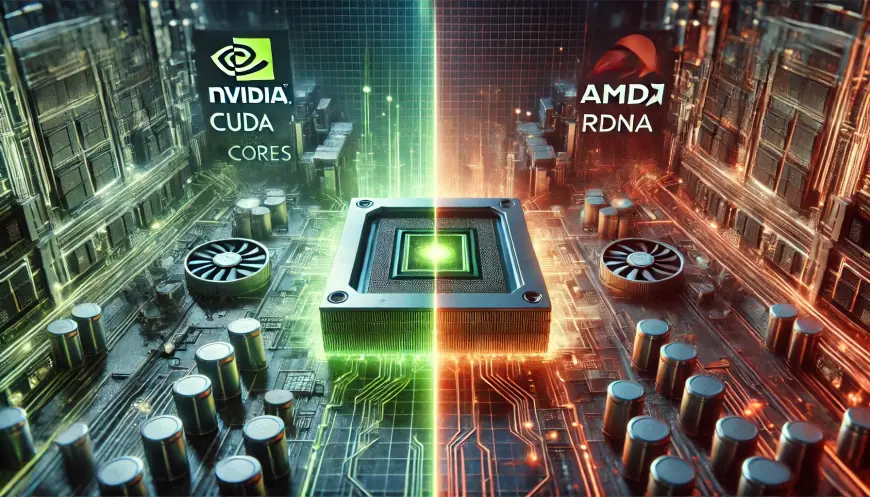Future of GPUs: Nvidia's CUDA Cores vs. AMD's RDNA Architecture
Explore the future of GPUs as Nvidia's CUDA Cores compete with AMD's RDNA Architecture, shaping gaming, AI, and creative performance.

When it comes to choosing the best GPU, gamers, creators, and tech enthusiasts often find themselves caught in the ultimate debate: Nvidia vs. AMD. At the heart of this battle lies Nvidia’s CUDA cores and AMD’s RDNA architecture. Both technologies are cornerstones of their respective brands and shape the future of GPU performance. So, what makes these technologies special, and which one is better for you? Let’s dive in.
Understanding Nvidia’s CUDA Cores
CUDA, or Compute Unified Device Architecture, is Nvidia’s proprietary technology. CUDA cores are essentially tiny processors within Nvidia GPUs that handle parallel computations. This design enables GPUs to excel in complex tasks like gaming graphics, video rendering, machine learning, and AI applications.
Why CUDA Cores Matter:
-
Advanced Performance: CUDA cores are optimized for compute-intensive workloads, making Nvidia GPUs a favorite for professional applications like 3D modeling and AI.
-
Software Ecosystem: Nvidia offers a strong software stack, including CUDA SDK and TensorRT, which caters to developers and creators.
-
Ray Tracing Leader: Nvidia’s RTX series GPUs leverage CUDA cores to deliver stunning ray-traced visuals in real time.
Best for: Professionals in content creation, AI researchers, and gamers seeking high-end performance in ray-traced games.
Exploring AMD’s RDNA Architecture
AMD's RDNA (Radeon DNA) is the architecture behind its powerful Radeon GPUs. RDNA focuses on delivering a balanced mix of gaming performance, efficiency, and affordability, ensuring a top-tier gaming experience for all types of users.
Key Features of RDNA Architecture:
-
Gaming-Centric: RDNA is optimized specifically for gaming, offering excellent frame rates and visual fidelity at competitive price points.
-
Power Efficiency: RDNA-based GPUs, like the Radeon RX series, consume less power while delivering high performance.
-
Smart Access Memory (SAM): AMD GPUs work seamlessly with Ryzen processors, offering better system-wide performance.
-
FSR (FidelityFX Super Resolution): AMD’s answer to Nvidia’s DLSS, FSR enhances performance in games by upscaling lower-resolution images.
Best for: Gamers on a budget, e-sports enthusiasts, and those looking for an energy-efficient GPU option.
Nvidia CUDA vs. AMD RDNA: Key Comparisons
|
Feature |
Nvidia CUDA |
AMD RDNA |
|
Performance |
Best for AI, rendering, and professional tasks |
Ideal for gaming and price-conscious users |
|
Ray Tracing |
Superior ray-tracing capabilities |
Competitive but slightly behind Nvidia |
|
Efficiency |
High performance, higher power usage |
Optimized power efficiency |
|
Software Ecosystem |
Extensive, developer-friendly |
Growing, with focus on gaming tools |
|
Price |
Premium |
Affordable |
What Does the Future Hold?
As gaming and AI evolve, both Nvidia and AMD are pushing the boundaries of GPU technology:
-
Nvidia: Future GPUs will likely leverage more advanced CUDA core technology, improving machine learning performance, ray tracing, and professional workflows. The Nvidia DLSS (Deep Learning Super Sampling) ecosystem will continue to grow, making gaming and rendering smoother.
-
AMD: RDNA's future will focus on efficiency and affordability. With RDNA 3 already making waves, AMD is working to close the gap in ray tracing while enhancing FSR capabilities to provide gamers with better performance and visuals at lower costs.
Which Should You Choose?
Choosing between Nvidia’s CUDA cores and AMD’s RDNA architecture boils down to your needs:
-
Pick Nvidia if you’re a creator, researcher, or gamer seeking cutting-edge ray tracing and AI-powered features.
-
Go for AMD if you’re a gamer who prioritizes affordability, power efficiency, and solid gaming performance.
Final Thoughts
Both Nvidia and AMD have their strengths, and neither is a one-size-fits-all solution. Whether you’re gaming, creating, or diving into AI research, understanding the core technologies like CUDA and RDNA will help you make an informed decision. No matter which brand you choose, the future of GPUs promises exciting advancements for everyone.
So, what’s your pick for the ultimate GPU battle? Let us know!












